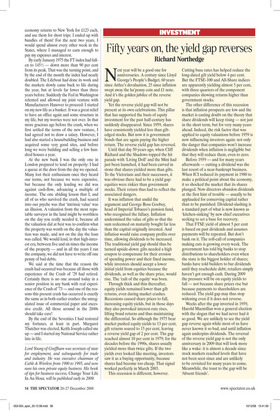Fifty years on, the yield gap reverses
Richard Northedge
Next year will be a good one for anniversaries. A century since Lloyd George’s People’s Budget, 60 years since Attlee’s devaluation, 25 since inflation swept away the ha’penny coin and £1 note. And it’s the golden jubilee of the reverse yield gap.
Yet the reverse yield gap will not be present at its own celebrations. This pillar that has supported the basis of equity investment for the past half-century has suddenly disappeared. Since 1959, shares have consistently yielded less than giltedged stocks. But now it is government bonds that are again paying the higher return. The reverse yield gap has reversed.
Until that day 50 years ago, when Cliff Richard and the Shadows topped the hit parade with ‘Living Doll’ and the Mini had just been launched, it had been carved in stone that shares yielded more than gilts. To the Victorians and their successors, it was obvious there had to be a yield gap: equities were riskier than government stocks. Their return thus had to reflect the associated dangers.
It was inflation that undid the argument and George Ross Goobey, head of Imperial Tobacco’s pension fund, who recognised the fallacy. Inflation undermined the value of gilts so that the sum redeemed on maturity bought far less than the capital originally invested. And inflation would raise company profits over time, allowing dividends to be increased. The traditional yield gap should thus be turned upside-down: gilts needed a high coupon to compensate for their erosion of spending power and their fixed income, while investors should accept a lower initial yield from equities because the dividends, as well as the share price, would rise. The ‘cult of the equity’ was born.
Through thick and thin thereafter, equity yields remained lower than gilt returns, even during market crashes. Recessions caused share prices to fall, increasing equity yields, but in those days they also provoked interest-rate rises, lifting bond returns and thus maintaining the differential. So although the 1975 bear market pushed equity yields to 13 per cent, gilt returns soared to 15 per cent, leaving a reverse yield gap of 2 per cent. The gap reached almost 10 per cent in 1979; for the decades before the 1990s, shares usually yielded more than twice gilts. If the two yields ever looked like meeting, investors saw it as a buying opportunity, because shares had become too cheap. That signal worked perfectly in March 2003.
This recession is different, however. Cutting base rates has helped reduce the long-dated gilt yield below 4 per cent. But the FTSE-100 and All-Share indices are apparently yielding almost 5 per cent, with three quarters of the component companies showing returns higher than government stocks.
The other difference of this recession is that inflation prospects are low and the market is casting doubt on the theory that share dividends will keep rising — not just in the short term, but for very many years ahead. Indeed, the risk factor that was applied to equity valuations before 1959 is now influencing investors again: not only the danger that companies won’t increase dividends when inflation is negligible but that they will reduce them, even to zero.
Before 1959 — and for many years afterwards — cutting a dividend was the last resort of a near-bankrupt business. When ICI reduced its payment in 1980 to make a political point about the economy, it so shocked the market that its shares plunged. Now directors abandon dividends at the first hint of trouble — usually to be applauded for conserving capital rather than to be punished. Dividend-slashing is a standard part of what is now known as ‘kitchen-sinking’ by new chief executives seeking to set a base for recovery.
That FTSE yield of almost 5 per cent is based on past dividends and assumes payments will be repeated. But don’t bank on it. The roll-call of companies making cuts is growing every week. The government has told big banks to stop distributions to shareholders even when the state is the biggest holder of shares; banks have told builders to bar dividends until they reschedule debt; retailers simply haven’t got enough cash. During 2009 the pressure will be on equity yields to fall — not because share prices rise but because payments to shareholders are reduced. The yield gap may thus stop widening even if it does not reverse.
Weeks after the gap inverted in 1959, Harold Macmillan won a general election with the slogan that we had never had it so good. We are unlikely to see the yield gap reverse again while most of us have never known it so bad, and until inflation again underpins dividends. The reversal of the reverse yield gap is not the only anniversary in 2009 that will look more like a wake: it is almost a decade since stock markets reached levels that have not been seen since and are unlikely to be revisited for many years to come. Meanwhile, the toast to the gap will be ‘Absent friends’.






















































































































 Previous page
Previous page